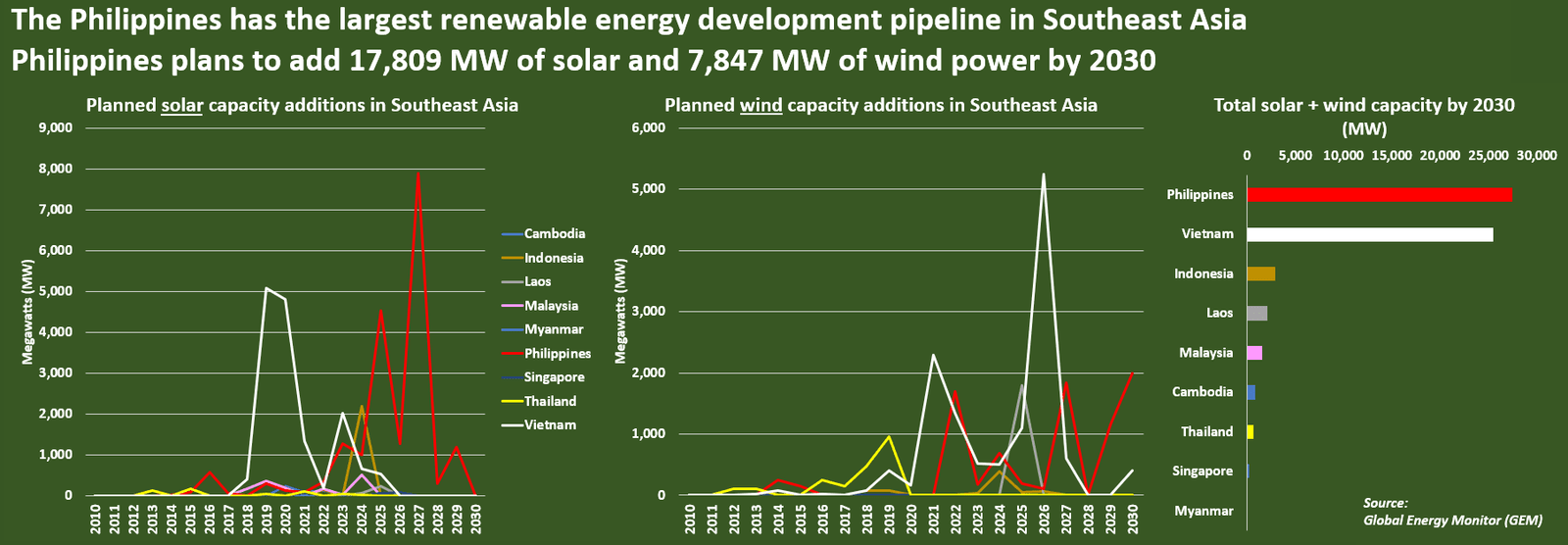The Philippines is accelerating its transition to clean energy. With record results from recent Philippines renewable energy auctions, the country is laying the groundwork for long-term energy security, lower electricity costs, and stronger investor confidence.

Strong Results from the Fourth Auction
In the Fourth Green Energy Auction (GEA-4), the Philippines secured 9.4 GW of renewable energy capacity out of a 10.65 GW target. That’s an 88% subscription rate, reflecting strong private-sector interest. A total of 111 bids were accepted, covering ground-mounted, rooftop, and floating solar projects, as well as onshore wind and solar-plus-storage systems.
These projects are set to deliver electricity between 2026 and 2029. They will directly support the national goal of 35% renewable energy by 2030 and 50% by 2040.
Momentum from Previous Philippines Renewable Energy Auctions
The latest results build on the success of GEA-3, which had drawn 7.5 GW of bids against a 4.65 GW target. That auction highlighted interest in geothermal, pumped-storage hydropower, and impounding hydropower. Each awarded project secured a 20-year supply contract, ensuring stability for investors and consumers alike.
These repeated oversubscriptions demonstrate a vibrant market where investors see renewable energy as a reliable growth sector.
Scale of National Renewable Contracts
Beyond individual auctions, the Department of Energy has awarded 1,392 renewable energy service contracts as of April 2025. These contracts carry a potential capacity of 152 GW, showing how rapidly the country is scaling up its clean energy ambitions.
Out of nearly 7,000 committed power projects in 2025, more than 3,900 are renewable facilities. Most are solar projects (3,060), followed by wind (759), geothermal (68), hydropower (35), and biomass (1). This breadth highlights how the Philippines is embracing a diverse mix of technologies to strengthen its energy transition.
Read Also: Can Philippines Offshore Wind Energy Save the Grid?
Philippines Renewable Energy Auctions: Investment and International Partnerships
The Philippines’ renewable auctions are not just about capacity—they are also about unlocking investment. One program alone is expected to catalyze $20 billion in renewable energy and efficiency projects over 10 years.
At Abu Dhabi Sustainability Week 2025, the Philippines signed agreements targeting up to 10 GW of renewable energy capacity and $15 billion in investments. These projects span solar, wind, and battery storage, reflecting both domestic and global confidence in the country’s clean energy market.
Benefits for Consumers and Energy Security
Auctions play a vital role in making clean energy affordable. By ensuring competitive pricing, the Philippines has managed to reduce electricity rates and promote a level playing field for new market entrants.
Greater reliance on renewable energy also shields the economy from price shocks in global fossil fuel markets. This strengthens energy security while making power more reliable and affordable for households and businesses across Luzon, Visayas, and Mindanao.
Read Also: Philippines Solar Power Drop Could Slash Power Prices by 24% by 2029
Philippines Renewable Energy Auctions: A Path Toward a Resilient Future
The results of recent Philippines renewable energy auctions confirm that the transition is not only underway but accelerating. With strong private-sector participation, ambitious government targets, and international support, the Philippines is positioning itself as a clean energy leader in Southeast Asia. The challenge now lies in ensuring smooth project execution, timely grid integration, and consistent policy support. If these are addressed, the auctions could become the cornerstone of a resilient, low-carbon energy future.

